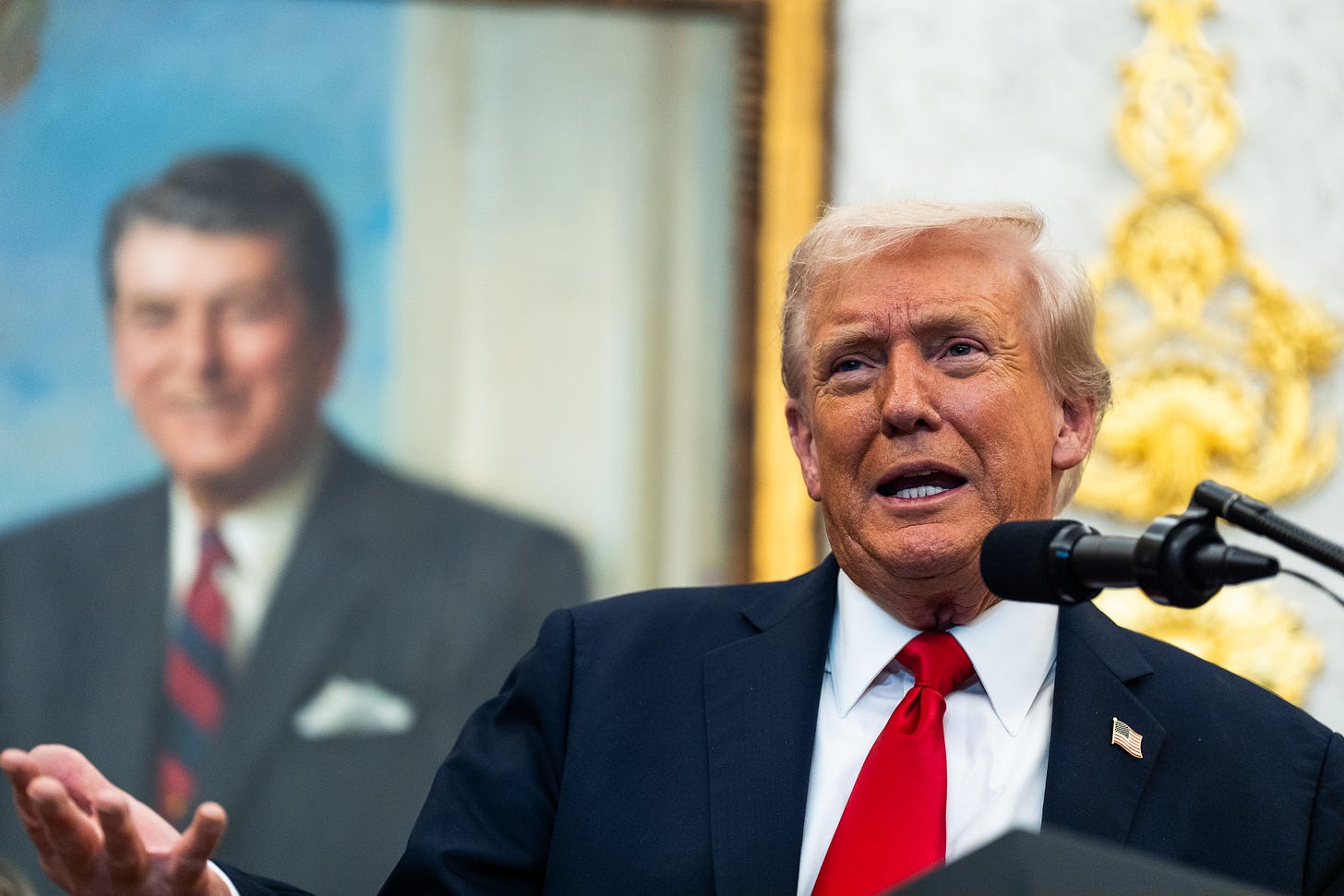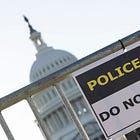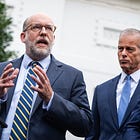Deregulation for Me, Regulation for Thee
Trump hasn’t actually reduced the burden of the administrative state—he’s just shifted it onto all of us.

This article is part of an ongoing project by American Purpose at Persuasion on “The ‘Deep State’ and Its Discontents.” The series aims to analyze the modern administrative state and critique the political right’s radical attempts to dismantle it.
To receive future installments into your inbox—plus more great pieces by American Purpose and Francis Fukuyama’s blog—simply click on “Email preferences” below and make sure you toggle on the buttons for “American Purpose” and “Frankly Fukuyama.”
One of the centerpieces of Trump’s second term has been his all-out war on the administrative state. This has taken a dizzying variety of forms, from mass firings of career civil servants, to reorienting agencies at express odds with their mandates, to the unilateral creation of new agencies devoted to reshaping the machinery of the government in his image. All of these actions are underwritten by the same idea: the administrative state constitutes a burden on the American public, and that burden should be reduced.
There is a modicum of logic underlying this idea. Government administration is not exactly famed for its efficiency. As anyone who has participated in regulation knows, the regulatory process rarely runs a straight line from aim to output. It is not a stretch to think that the administrative bureaucracy of our government could be made more efficient.
That is not what Trump has done.
What Trump has done is not reduce the burden of the administrative state—he’s just made someone else carry it. By converting the administrative state from a regulatory entity into a purely political mouthpiece for our commander-in-chief, Trump has shifted the burden of the state’s operation from the government to the people being operated on. Even more to the point: when Trump talks about reducing the burden of the administrative state, he’s not talking about reducing the burden on us—he’s talking about reducing the burden on himself.
A Legal Burden
The notion of burden plays a large role in our legal system. Generally speaking, a legal burden is one of the main mechanisms for how the law determines what normal should be. For instance, we put the burden of proof on the person bringing a suit rather than the person who is being sued, by requiring them to prove their case by a “preponderance of the evidence.” This in turn helps to set the norm as “not being sued” rather than “being sued,” because putting the burden on the person bringing the suit to affirmatively prove their case makes it less likely that the suing will happen at all.
In criminal cases, we take this standard even farther, raising the burden of proof to “beyond a reasonable doubt.” This helps to set the norm as “rarely being prosecuted” rather than “often being prosecuted”—because putting such a difficult-to-meet standard on the government to make out a criminal case makes it less likely that the government brings that case in the first place.
These are far from the only examples of how the law uses burdens. There are burdens of proof that determine who has the responsibility of persuading the decisionmaker at each stage of trial; there are burdens of production, which determine who has the responsibility to cough up the evidence; there are undue burdens, which determine to what extent certain constitutional rights have been unacceptably curtailed by government action; the list goes on. Saddling people with the burden of actually doing something is one of the main ways that our legal system sets the standard for behavior in our society.
And that includes the regulatory burden of the administrative state. This happens in a few different ways. By the very nature of regulation, the government is almost always the enforcing party, meaning that they are subject to the same burdens of litigation that any initiating party would be. But at an even more fundamental level, the administrative state is designed to keep as much of the burden of regulation on the government for as long as possible, primarily by setting evidence-based standards for more aggressive forms of regulatory enforcement.
For instance, financial regulation is managed by a complex series of overlapping processes, each of which carries an increasing burden—in terms of time, effort, and money—to the entity being regulated. The lowest level might include self-reporting by banks on their own behavior; at the next level, semi-regular examinations conducted by regulators, which take a closer look at a bank’s processes to ensure that they pass muster; at the next level, one-off requests for information regarding a suspected violation, which force the banks to go digging for much more comprehensive information that they might not have readily available; culminating in, ultimately, civil or legal suits launched by the government, which seeks to impose penalties for severe violations.
Each of these levels of enforcement—and the numerous other levels that fall in between—represents an increasing burden on the regulated party, and is accordingly utilized only if the regulator determines that the facts support taking that additional step. This scheme of escalating levels of regulation is echoed throughout the administrative state. The net effect is to consistently reserve the strongest remedies, and the burden that those remedies represent, for only the situations where those costs are justified by the facts.
But Trump’s never exactly been one for the facts.
A Regulator With One Tool
The administrative state under Trump shortcuts the entire process of escalating remedies, and jumps straight to the most aggressive regulatory tools available—which puts the burden of that regulation squarely on the regulated party instead of the regulator. In other words, his supposed assault on the administrative state is less an assault on the state itself than it is an assault on the notion that the state should have to do any homework before enforcing the executive’s agenda.
For instance, as part of the about-face by the Equal Employment Opportunity Commission (EEOC) on diversity issues—seeking to root out rather than encourage DEI initiatives—it issued public letters to 20 of the country’s most prominent law firms (including my former firm, WilmerHale) this past March. Those letters requested a wide variety of information from the firms, including detailed personal information about applicants and employees, and indicating concern that the firms’ DEI policies violated Title VII of the Civil Rights Act of 1964.
Even setting aside the legal tenuousness of these allegations, the letters jumped over numerous stages in the EEOC’s normal regulatory process. That process normally would have included not only a formal investigation, but non-public requests for information—requests that almost certainly did not happen, as the new EEOC had not yet had time to make such requests. To ignore these typical steps was unusual—so unusual, in fact, that it prompted seven former EEOC officials to send a letter to the new acting chief of the EEOC stating that “[t]hese letters appear to exceed your authority under Title VII,” before detailing the regulatory process that should have taken place.
This is far from the only example. From the DOJ’s indictment of former FBI Director James Comey, to ICE’s aggressive and inhumane enforcement policies, agencies in the Trump administration have shown a reckless willingness to jump straight to the most aggressive form of regulatory enforcement, regardless of whether it is justified by the facts. Nor is this aggressiveness restricted merely to enforcement actions: to date, the Brennan Center has counted more than 80 regulatory changes in the first nine months of Trump’s second term, all of which constitute a moving target for regulated parties and a significant burden to meet. This litany of haphazard regulatory change blatantly contradicts Trump’s aggressive “deregulation” agenda.
What’s more, not only does this shift the burden of regulation to the people being regulated, all of whom must now affirmatively work to prove their own innocence, rather than waiting for the government to assemble enough information to conduct its own assessment. It actively adds to that burden. Under Trump, agencies have interpreted their legislative mandate so aggressively and nonsensically (e.g. having the EEOC attack DEI initiatives) that it stretches those mandates to the breaking point, effectively saddling regulated parties with the burden of meeting legal standards that have not even been passed yet. This shortcuts the entire legislative process—which saves Trump the burden of having to deal with it.
In brief, Trump has converted the administrative state into a machine for turning his opinions into law with almost no oversight whatsoever—and he’s put the burden on us.
Trump’s Burden On Us
In American law, procedure is where the rubber meets the road. It’s where the Constitution’s guarantee of life, liberty, and property is given force in the form of due process; it’s where the Fourth Amendment’s right against unreasonable searches and seizures is protected via Miranda warnings; and it’s where our collective decisions as to what should constitute “normal” are given expression in the form of legal burdens.
The administrative state has historically placed the burden of regulation predominantly on the government, in keeping with this country’s strong individualist ethos. By converting the administrative state into a political pulpit first and a regulator second, Trump has inverted that balance. Now, the burden is on the regulated party to prove their own innocence—not only in response to the laws that currently exist, but also to ones that Trump would merely like to exist.
This is in complete opposition to Trump’s extremely loud proclamations that he is lessening the burden of the administrative state. Yet he keeps on touting how much more efficient things are—likely because from his standpoint, as the head of the administrative state, the burden is going away. It’s just not his problem anymore.
Now it’s ours.
Matthew Wollin is a former lawyer turned legal journalist. He’s written for Mother Jones, Newsweek, Slate, and The New Republic. His Substack Should You Care? helps make sense of legal issues for non-lawyers and answers the never-ending news cycle’s eternal question: should you care?
Follow Persuasion on Twitter, LinkedIn, and YouTube to keep up with our latest articles, podcasts, and events, as well as updates from excellent writers across our network.
And, to receive pieces like this in your inbox and support our work, subscribe below:






This is a weak-ass job since you did not do your homework on the Trump administration deregulation efforts. https://www.brookings.edu/articles/tracking-regulatory-changes-in-the-second-trump-administration/
It is absolutely inaccurate to claim Trump is increasing regulations. All of the work he and Scott Bessent and others are doing is to lower the barriers and blocks to economic development to inspire industrial growth that benefits all the thees.
You don't have to agree with it. For example, maybe you are committed to the climate crisis hoax and don't welcome more fossil fuel exploration and production. But you should at least acknowledge it if you are going to make this criticism. Reducing the regulatory barriers to traditional organic energy production is regulation for thee.
interesting perspective. Seems like a fair-enough description.